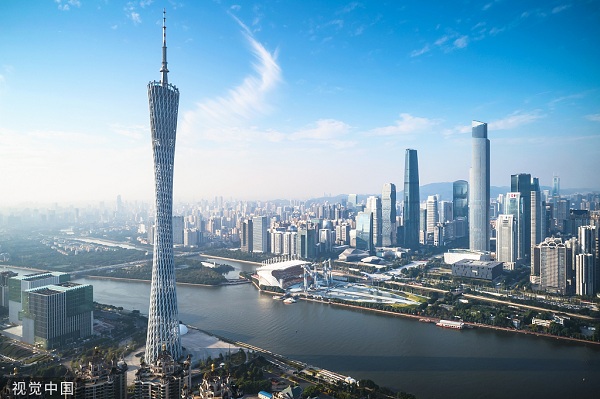Prospects bright for cooperation between HK, Nansha

A view of Canton Tower in Guangzhou, Guangdong province. [Photo/VCG]
Located at the southernmost end of the city of Guangzhou, Guangdong province, is Nansha district, a State-level new area overseen by the Guangzhou municipal government. To its 846,000-plus residents, it is simply a place to live. But to the Hong Kong Special Administrative Region, it is a place brimming with opportunities.
As the geographical center of the Pearl River region, Nansha's 803 square kilometers of land — approximately two-thirds the size of Hong Kong — boasts convenient transportation links to Hong Kong, an international cruise terminal, a container terminal with a throughput similar to Hong Kong's, affordable living and plenty of green space.
And with an average three-bedroom apartment costing no more than 4,000 yuan ($560) per month in rent, it is no wonder that the State Council has been supporting greater collaboration between Hong Kong and Nansha.
A 35-minute journey to Nansha via high-speed rail from West Kowloon and an hourlong ferry ride from Tsim Sha Tsui are just some of the many modes of transportation available to Hong Kong residents.
On June 14, the State Council, China's Cabinet, released a 26-point document that detailed incentives ranging from healthcare, employment, education, tax incentives and social welfare to attract Hong Kong residents to the area.
The document, titled "Master Plan of Guangzhou, Nansha on Deepening Comprehensive Cooperation between Guangdong, Hong Kong and Macao with a Global Perspective", is a highly ambitious blueprint for consolidating Hong Kong, Macao and cities on the mainland into the Guangdong-Hong Kong-Macao Greater Bay Area.
While Nansha is only a district in the Greater Bay Area — which covers over 56,000 square kilometers and has 80 million people — it is nonetheless an area that offers much promise.
In fact, the State Council's document is the blueprint for transforming Nansha into the beating heart of the Greater Bay Area economic powerhouse by 2035.
There are five key development directions for Nansha: encourage technological innovation to facilitate industrial development; create platforms to encourage young entrepreneurs and startups; establish a gateway between China and the international community; become a "center of excellence" that sets the standards for the Greater Bay Area's rules and regulations; and establish a slew of high-quality urban development projects.
According to the master plan, from now until 2024, the cap of Nansha local government to raise new debt will be lifted by 10 billion yuan each year, and the governments of Guangdong and Guangzhou will remove restrictions on Nansha's current annual land use.
Young talent and budding entrepreneurs from Hong Kong should look to Nansha for growing their businesses and putting down roots.
To that end, education will also be at the heart of Nansha's development. The Hong Kong University of Science and Technology (Guangzhou) has a campus in Nansha, and the Minxin Hong Kong School — a nonprofit school in Nansha — has been set up for the sole purpose of accommodating Hong Kong children at the primary and secondary school levels.
The central government has also confirmed that Hong Kong's, Macao's and Nansha's healthcare sectors will be working closely together.
So what does this mean for Hong Kong, and what will it bring to the table?
Unfortunately, we are still contending with a shortfall of doctors. As it stands, there are 15,000 registered doctors serving 7.4 million Hong Kong residents. Yet while we may not be able to supply medical personnel to Nansha, our internationally recognized standards of care and management are valuable assets.
In Hong Kong, medical professionals and their standards of care are regulated by the Medical Council of Hong Kong, which also protects patients in the event of any professional misconduct.
Hong Kong's fair and mature legal system is also a source of pride. Its unique hybrid system of common law and civil law is just one of the many prized features of the city's legal framework.
In cases involving patient-doctor conflicts, the city has civil tribunals for less-serious complaints and various courts of justice for handling medical cases with criminal elements.
Hong Kong has long maintained one of the lowest rates of infant mortality and maternal mortality in the world. And for seven consecutive years, it has had one of the highest life expectancies in the world — with women living up to 87.7 years and men 83.
Each city in the Greater Bay Area has something to bring to the table, but there is plenty to be done. This is where the Consultative Committee on Guangdong-Hong Kong Cooperation (Guangzhou Nansha) comes in.
The consultative committee was established in April last year for the purpose of strategizing policymaking and implementation for issues specific to Hong Kong-Nansha relations. There are 14 special expert groups for specific policy areas, including the medical affairs task group, whose task is to initiate a medical "free flow channel" between Hong Kong and Nansha.
The consultative committee is just one of many institutions created for optimizing healthcare cooperation between Guangdong and Hong Kong. For example, there is the Guangdong Provincial Eye Health Association and the Greater Bay Area Ophthalmologists Alliance.
While the reality of Hong Kong residents becoming long-term residents of Nansha seems like a distant prospect, the time will come sooner than we think. And if the last two years or so have taught us anything, it is that we must always expect the unexpected and remain prepared for anything.
All rights reserved. Presented by China Daily









